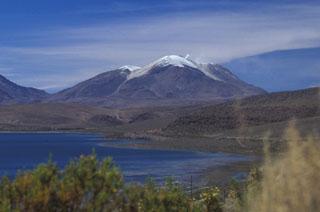Report on Guallatiri (Chile) — May 1991
Bulletin of the Global Volcanism Network, vol. 16, no. 5 (May 1991)
Managing Editor: Lindsay McClelland.
Guallatiri (Chile) Strong fumarolic activity
Please cite this report as:
Global Volcanism Program, 1991. Report on Guallatiri (Chile) (McClelland, L., ed.). Bulletin of the Global Volcanism Network, 16:5. Smithsonian Institution. https://doi.org/10.5479/si.GVP.BGVN199105-355020
Guallatiri
Chile
18.42°S, 69.092°W; summit elev. 6071 m
All times are local (unless otherwise noted)
Two strongly active zones of fumaroles were observed during a summit visit on 2 November 1990. The more intense fumaroles, 80 m below the . . . summit, produced a plume 200 m high accompanied by a jet-engine noise. Some boiling mud pools were also seen. The second zone, on the S side of the volcano at ~3,000 m elev, contained about 10 fumaroles. The volcano was otherwise snow-covered.
Geological Summary. One of northern Chile's most active volcanoes, Volcán Guallatiri is a symmetrical ice-clad stratovolcano at the SW end of the Nevados de Quimsachata volcano group. It lies just W of the border with Bolivia and is capped by a central dacitic dome or lava complex, with the active vent situated on its S side. Thick lava flows are prominent on the lower N and W flanks of the andesitic-to-rhyolitic volcano. Minor explosive eruptions have been reported since the beginning of the 19th century. Intense fumarolic activity with "jet-like" noises continues, and numerous solfataras extend more than 300 m down the W flank.
Information Contacts: P. Vetsch and R. Haubrichs, SVG, Switzerland.

